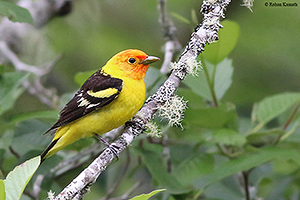 |
Western Tanager
Piranga ludoviciana |
|
STANFORD LOCATIONS: Uncommon migrant and rare winter resident in various habitat types throughout campus. Often present in oaks and eucalyptus near the Mausoleum, and occasional individuals overwinter here. |
 |
Location |
Type |
Mating System |
Parental Care |
2ndary Diet |
Strategy |
|
|
|
|
I: 13 DAYS ALTRICIAL |
|
|
|
|
|
MONOG ? |
MF |
|
|
| BREEDING: | Coniferous and mixed coniferous-deciduous woodland, mostly in mountains. ? broods. |
| DISPLAYS: | ? |
| NEST: | Rarely in deciduous tree; in fork on horizontal branch, well out from trunk; of twigs, rootlets, moss, lined with hair, rootlets. |
| EGGS: | Bluish, marked with browns, often wreathed. 0.9" (23 mm). |
| DIET: | Includes few buds. |
| CONSERVATION: | Winters mostly in highlands from c Mexico to Costa Rica, in variety of forest, woodland, and scrub, esp pine, pine-oak, forest edge and clearings. Rare cowbird host. |
| NOTES: | Female does not flush easily when incubating. |
| ESSAYS: | Decline of Eastern Songbirds; Color of Birds; Wintering and Conservation. |
| REFERENCES: | Bent, 1958. |
| Help | Abbreviations | Species-Alphabetical | Species-Taxonomic | Essays-Alphabetical | |
| Except for Stanford Locations, the material in this species treatment is taken, with permission, from The Birder's Handbook (Paul Ehrlich, David Dobkin, & Darryl Wheye, Simon & Schuster, NY. 1988). | |||||